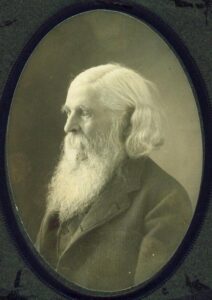PriceCounty.fun
Village Review
1872-1894-1930
By Wm. J. Bendixen
A review of the village business people, past and present, by Wm. J. Bendixen.

Alexander Prentice
There were very few white settlers in this area of the state, except in a few settlements and small lumbering towns along the main river. Now it is cut up in every direction by railroads and is producing enormous quantities of agricultural and dairy products, besides other manufacturing.
In 1872 the W. C. R. R. Co. started building the railroad north through what seemed an impenetrable wilderness. The first year the road was built as far as where the city of Medford is now located, 67 miles from Stevens Point, and the next year it was extended to Worcester, or 101 miles from Stevens Point; six miles north of Prentice. At that time the panic of 1873 struck the country and work on the road was abandoned until 1876, when it was completed.
Prentice, with a population of about 600 inhabitants, is situated in the southern part of Price county, at the junction of the Chicago and Ashland division of the Soo Line (formerly the W. C. R. R.), about 180 miles east of Minneapolis and about 370 mile north of Chicago. With United States Highway No. 8 and State Trunk No. 12 passing through, the village is surrounded by a fine, thrifty and growing dairy community.
The first settlement was made here about 1880-81. The first mill was built in 1881 by the Jump River Lumber Co. The U. S. Hide & Leather Co. operated a large tannery plant here from 1891 to 1905, but after several disastrous fires in the first part of this century they discontinued the business here and dismantled the plant and moved elsewhere.
Prentice was named after Alexander Prentice, a timber cruiser, who came here with the Jump River Lumber Co., and was apparently quite popular.
Prentice has a High school and a State Graded school, employing eight teachers. There are five churches—Catholic, Congregational, Advent, Lutheran and Baptist, one of each. The Odd Fellows have a prosperous lodge and own their own building, which is occupied exclusively by Odd Fellows and Rebekahs. The American Legion and Auxiliary have camps here, as well as the Modern Woodmen and the Royal Neighbors. The Price County Canning Co. is one of the larger industries at Prentice. Last year this company canned 30,000 cases of peas, 8,000 cases of beans, 2,500 cases of carrots, 2,500 cases of beets, 125 cases of rutabagas. At the height of the canning season 120 men and women were employed at the factory, a total of $14,500 being paid out for labor. This company turns out an excellent class of products, which readily find a market. The output will undoubtedly increase from year to year.
Prentice has a very good electric lighting system, which is furnished by the Lake Superior District Power Co.
The Bell Telephone Co. services the village and surrounding territory with an efficient telephone line, giving good service to a large number of patrons.
Product, shipped last year about 4,500,000 pounds of cheese, paying about $624,000 for the same, although 1930 was an off year for dairying.
The Prentice Co-operative Creamery, with B. F. Buchholz, manager, and Paul Peterson, butter maker, is a valuable asset to the community. It is a member of the Wisconsin Co-operative Creamery Association and manufactures butter from pasteurized cream from T. B. tested area. In 1930 this concern handled 1,511,817 lbs. Of milk, 138,268 lbs. Of cream and made about 125,000 lbs. Of butter, paying out nearly $41,000 for butterfat. This company also manufactures casein from the skimmed milk.
There are two hotels here—The Blong Hotel and Café, owned and operated by Ed. Blong, on the European plan; giving day and night service; the Eagle Hotel, managed by Mrs. Bernard Lundgreen, is operated on the American plan, with Café in connection, and bus service to and from all trains, and free car parking space during the summer months. Both of these hotels cater to the tourist trade. Besides these is a good restaurant, conducted by Mrs. J. W. Wilund.
There are three general stores, of which the one conducted by S. W. Pierson is the pioneer business place in Prentice. Mr. Pierson came to the Untied States in 1807, and after working in different parts of the country, came to Prentice in 1889, where he worked for the Jump River Lumber Co. until 1892, when he started in business for himself and has continued ever since. He carries a general line of groceries, hardware, boots, shoes, rubber, sporting goods, gent’s furnishings, notions and fruits in season. Before coming to Prentice he had taught school at Ogema for five years.
The Prentice Co-operative Supply Co., with John E. Berglund manager, carries a general line of merchandise, including dry goods, boots, shoes, rubbers, groceries, hardware, flour, feed, salt and fertilizer; also a full line of Deere and Webber farm implements.
Rabenowich’s Department Store, which was recently established here, has an up-to-date merchandise line, carrying large stocks of dry goods, clothing, groceries, notions, boots, shoes, fruits, vegetables and meats.
B. Braunwarth deals in jewelry, watches, clocks, silverware, etc., and pays special attention to watch repairing.
S. T. Nelson, so far as we know, is the oldest continuous settler in Prentice. He came here in 1886 and soon after established a shoe shop, where he made a specialty of making the famous “Klondike” drivers’ and cruisers’ boots, but as factory work has crowded out hand work, he has abandoned this work and established a shoe hospital, with modern repair machinery and is now prepared to perform all kinds of shoe surgery in his little shop just north of the I. O. O. F. hall.
The Reed Lumber Co. carries a complete line of lumber, lath, shingles, sash doors, lime, cement, and all kinds of building material, coal and wood, as well as a full line of International farm implements, gas engines, cream separators, etc.